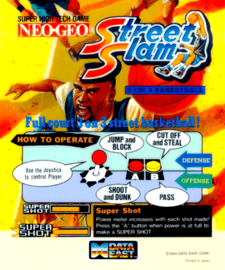Street Slam
| Street Slam | |
|---|---|
 | |
| Developer(s) | Data East |
| Publisher(s) |
Data East D4 Enterprise |
| Composer(s) | Tatsuya Kiuchi |
| Platform(s) | Neo Geo, Virtual Console |
| Release |
Neo Geo Virtual Console |
| Genre(s) | Sports |
| Mode(s) | Single-player, multiplayer |
Street Slam, known in Japan as Dunk Dream (ダンクドリーム) and known in Europe as Street Hoop, is a basketball video game developed by Data East for Neo Geo, released in 1994. The game features three-on-three basketball match-ups with a variety of different teams.
A sequel to the game, known as Dunk Dream '95 in Japan and Hoops '96 in Europe, was released in 1995. In 2010, the original game was released for the Wii on the Virtual Console, as well as part of the compilation Data East Arcade Classics.
Street Slam was the inspiration for The King of Fighters character Lucky Glauber.
Gameplay
In the US version of the game, players can select a three-player team from a selection of 10 cities in the United States. In the European and Japanese versions of the game, the cities are replaced with countries around the world. The selection screens, player skin colours and costumes also change between the versions.
Each team has a total of 18 points in several characteristics (Dunk, 3pts, Speed, and Defence), and 8pts max for each. Every team has its own strengths and weakness. For example, New York (America in the JP/EU Version) is good in dunks and bad in 3-pointers. On the other hand, Philadelphia (Taiwan in JP/EU version) is good in 3-pointers and bad in dunks.
Reception
On release, Famicom Tsūshin scored the Neo Geo version of the game a 25 out of 40.[1]
Next Generation reviewed the Neo-Geo version of the game, rating it two stars out of five, and stated that "Street Hoop is definitely arcade-style action and meant primarily for two players with its quick passing and under-sized court, and it translated well enough to the home system."[2]
Next Generation reviewed the arcade version of the game, rating it three stars out of five, and stated that "Blocky simplistic graphics and colorful but cheap-looking backgrounds won't attract gamers to this one, but when you get the chance to play, especially with a couple of friends, you can have some challenging fun."[3]
References
- ↑ NEO GEO GAMES CROSS REVIEW: ダンクドリーム. Weekly Famicom Tsūshin. No.332. Pg.24. 28 April 1995.
- ↑ "Finals". Next Generation. No. 9. Imagine Media. September 1995. p. 94.
- ↑ "Finals". Next Generation. No. 13. Imagine Media. January 1996. p. 175.
External links